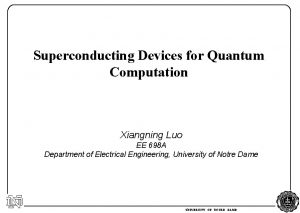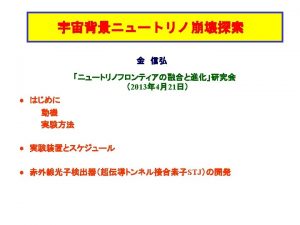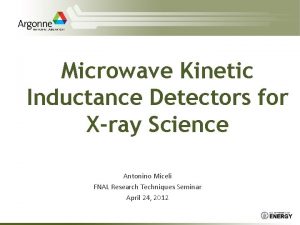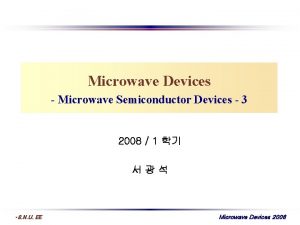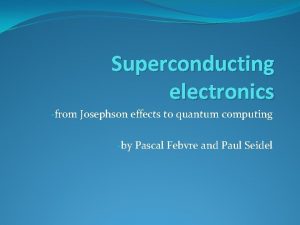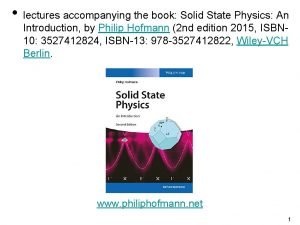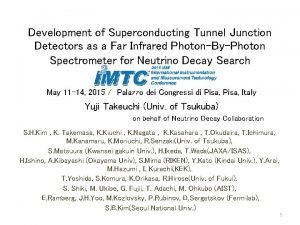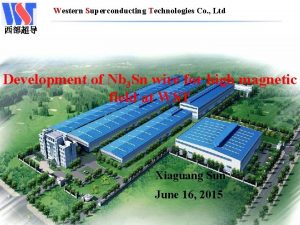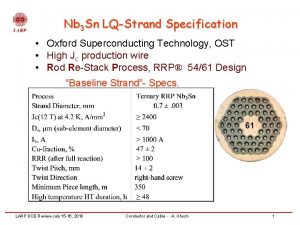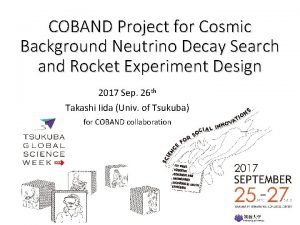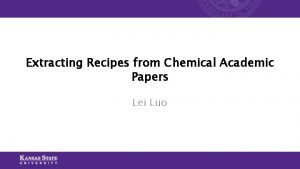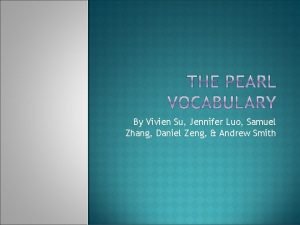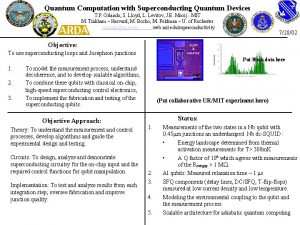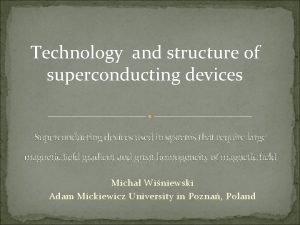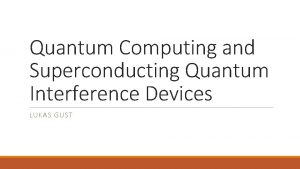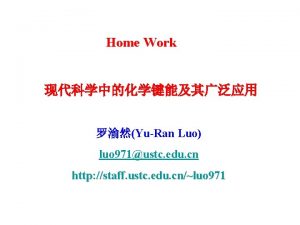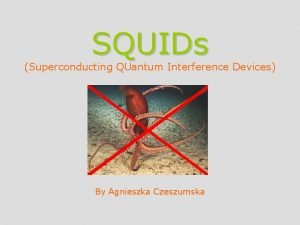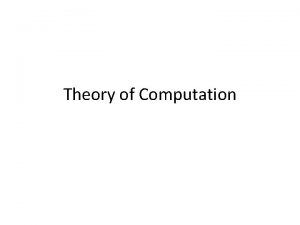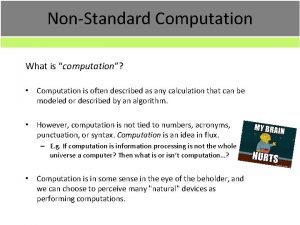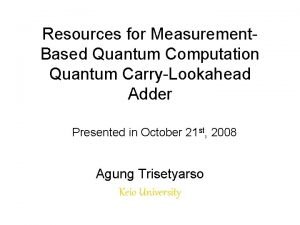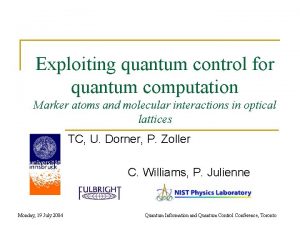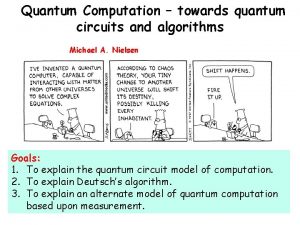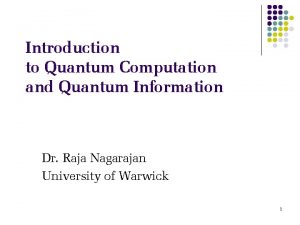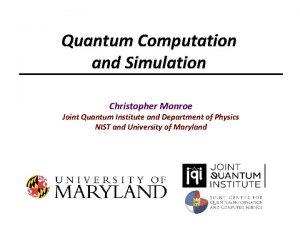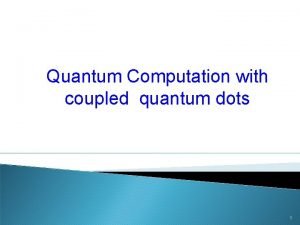Superconducting Devices for Quantum Computation Xiangning Luo EE














- Slides: 14

Superconducting Devices for Quantum Computation Xiangning Luo EE 698 A Department of Electrical Engineering, University of Notre Dame UNIVERSITY OF NOTRE DAME

Outline of Presentation Ø Introduction to quantum computation Ø Superconducting qubit devices Ø Josephson charge qubit Ø Qubits based on the flux degree of freedom UNIVERSITY OF NOTRE DAME

Quantum Computation Classical Computation: Classical logic bit: “ 0” and “ 1” Quantum Computation: Quantum bit, “Qubit”, can be manipulated using the rules of quantum physics Orthogonal quantum states |0> , |1> and their superposition |Ψ> = c 0|0> + c 1|1> A Quantum state of M bits is a superposition of 2 M states. The quantum computation is a parallel computation in which all 2 M basis vectors are acted upon at the same time. If one wanted to simulate a quantum computer using a classical computer one would need to multiply together 2 M dimensional unitary matrices, to simulate each step. A quantum computer can factorize a 250 -digit number in seconds while an ordinary computer will take 800 000 years! UNIVERSITY OF NOTRE DAME

Quantum Computation 0 |Ψ(0)> U(t 1, t 0) 1 Preparation: The initial preparation of the state defines a wave function at time t 0=0. |Ψ(1)> U(t 2, t 1) …. State evolution: Evolved by a sequence of unitary operations U(tn, tn-1) n |Ψ(n)> P(Ф)=|<Ф|Ψ(n)>|2 Measurement: Quantum measurement is projective. Collapsed by measurement of the state UNIVERSITY OF NOTRE DAME

Quantum Logic Gates Question: How to implement a general unitary operator? Answer: Introduce a complete set of logic gates. Any possible operation on an qubit register can be represented in terms of a suitable sequence of actions of such elementary logic gates It is proved that an arbitrary 2 x 2 unitary matrix may be decomposed as U= where α, β, ν, and δ are real-valued. UNIVERSITY OF NOTRE DAME

Superconducting Qubit Devices Any quantum mechanically coherent system could be used to implement the ideas of quantum computation. - single photons - nuclear spins - trapped ions - superconductors Advantage of solid state implementations Possibility of a scalable implementation of the qubits Superconducting devices The minimum levels of decoherence among solid state implementations. A promising implementation of qubit. two kinds of qubit devices either based on charge or flux degrees of freedom. UNIVERSITY OF NOTRE DAME

The Cooper Pair Box Qubit UNIVERSITY OF NOTRE DAME

The Cooper Pair Box Qubit System Hamiltonian Tunneling term A sudden square pulse is applied to the gate Vg Energy state of n Cooper pair The square gate pulse lasts for some time ∆t Vg returns to zero The probability that the state does not return to the ground state UNIVERSITY OF NOTRE DAME

The Cooper Pair Box Qubit UNIVERSITY OF NOTRE DAME

The Cooper Pair Box Qubit UNIVERSITY OF NOTRE DAME

The Cooper Pair Box Qubit UNIVERSITY OF NOTRE DAME

The superconducting Flux Qubit Coherent time evolution between two quantum states was observed. antisymmetric superposition clockwise Φ=h/4 e anticlockwise Flux qubit consists of 3 Josephson junctions arranged in a superconducting loop. Two states carrying opposite persistent currents are used to represent |0> and |1>. External flux near half Φ 0=h/2 e is applied. A SQIUD is attached directly. MW line provides microwave current bursts inducing oscillating magnetic fields. Current line provides the measuring pulse and voltage line allows the readout of the switching pulse. I. Chiorescu et al. , Science 299, 1869 (2003). UNIVERSITY OF NOTRE DAME

The superconducting Flux Qubit Measurements of two energy levels of qubit Qubit energy separation is adjusted by changing the external flux. Resonant absorption peaks/dips are observed. Dots are measured peak/dip positions obtained by varying frequency of MW pulse. The continuous line is a numerical fit giving an energy gap ∆ = 3. 4 GHz in agreement of numerical simulations. I. Chiorescu et al. , Science 299, 1869 (2003). UNIVERSITY OF NOTRE DAME

The superconducting Flux Qubit Different MW pulse sequences are used to induce coherent quantum dynamics of the qubit in the time domain. Rabi oscillations - when the MW frequency equals the energy difference of the qubit, the qubit oscillates between the ground state and the excited state. Resonant MW pulse of variable length with frequency F = E 10 is applied. MW F = 6. 6 GHz MW power 0 dbm, -6 dbm, and -12 dbm Linear dependence of the Rabi frequency on the MW amplitude, a key signature of the Rabi process. Decay times up to ~150 ns results in hundreds of coherent oscillations. The pulse length defines the relative occupancy of the ground state and the excited state. The switching probability is obtained by repeating the whole sequence of reequilibration, microwave control pulses, and readout typically 5000 times. I. Chiorescu et al. , Science 299, 1869 (2003). UNIVERSITY OF NOTRE DAME
 Superconducting devices in quantum optics
Superconducting devices in quantum optics Superconducting
Superconducting Superconducting tunnel junction
Superconducting tunnel junction Mkid
Mkid Superconducting tunnel junction
Superconducting tunnel junction Pascal febvre
Pascal febvre Superconducting ring
Superconducting ring Stj
Stj Western superconducting
Western superconducting Oxford superconducting technology
Oxford superconducting technology Coband
Coband Quantum physics vs quantum mechanics
Quantum physics vs quantum mechanics Quantum physics vs mechanics
Quantum physics vs mechanics Lei luo build
Lei luo build Inaudibly synonym
Inaudibly synonym
